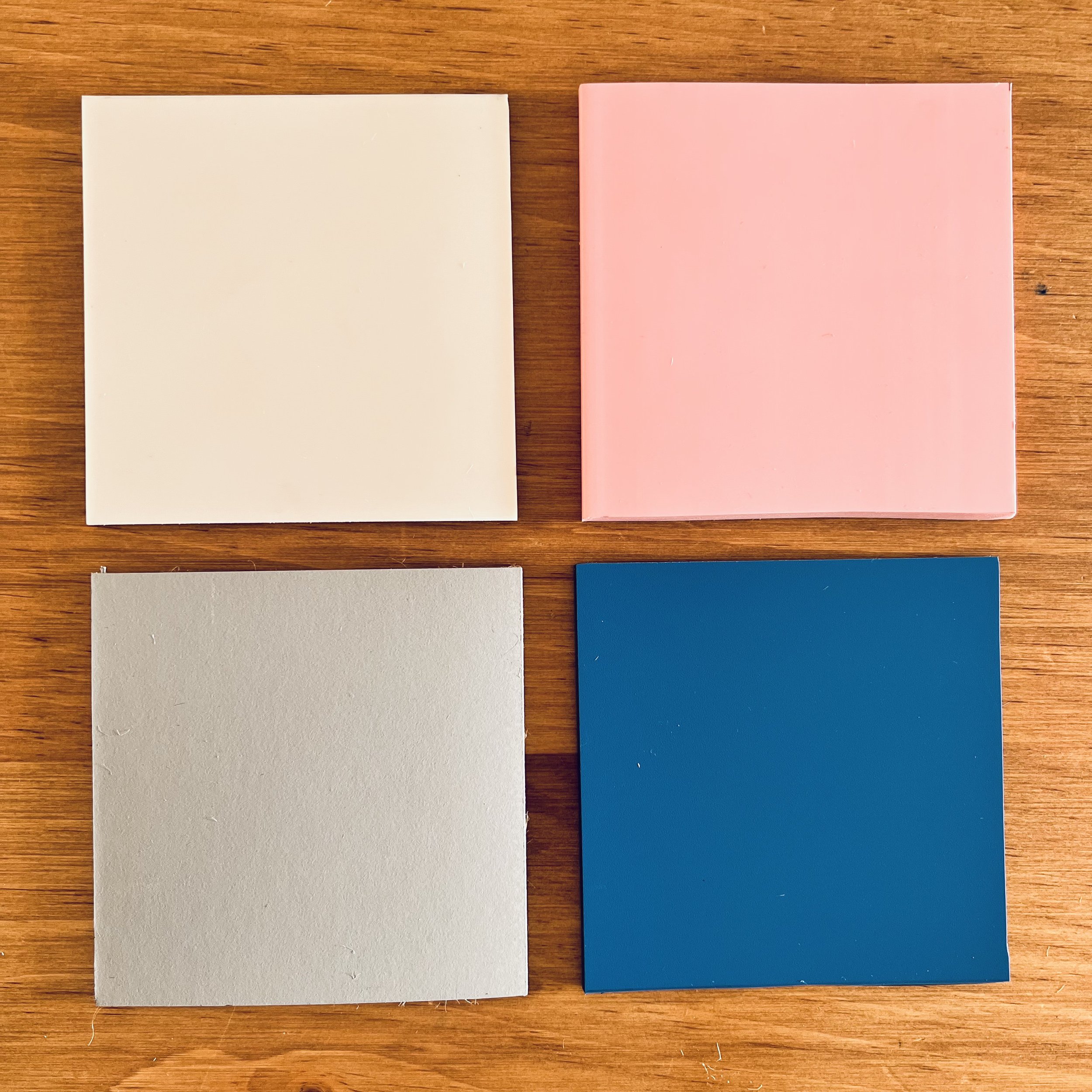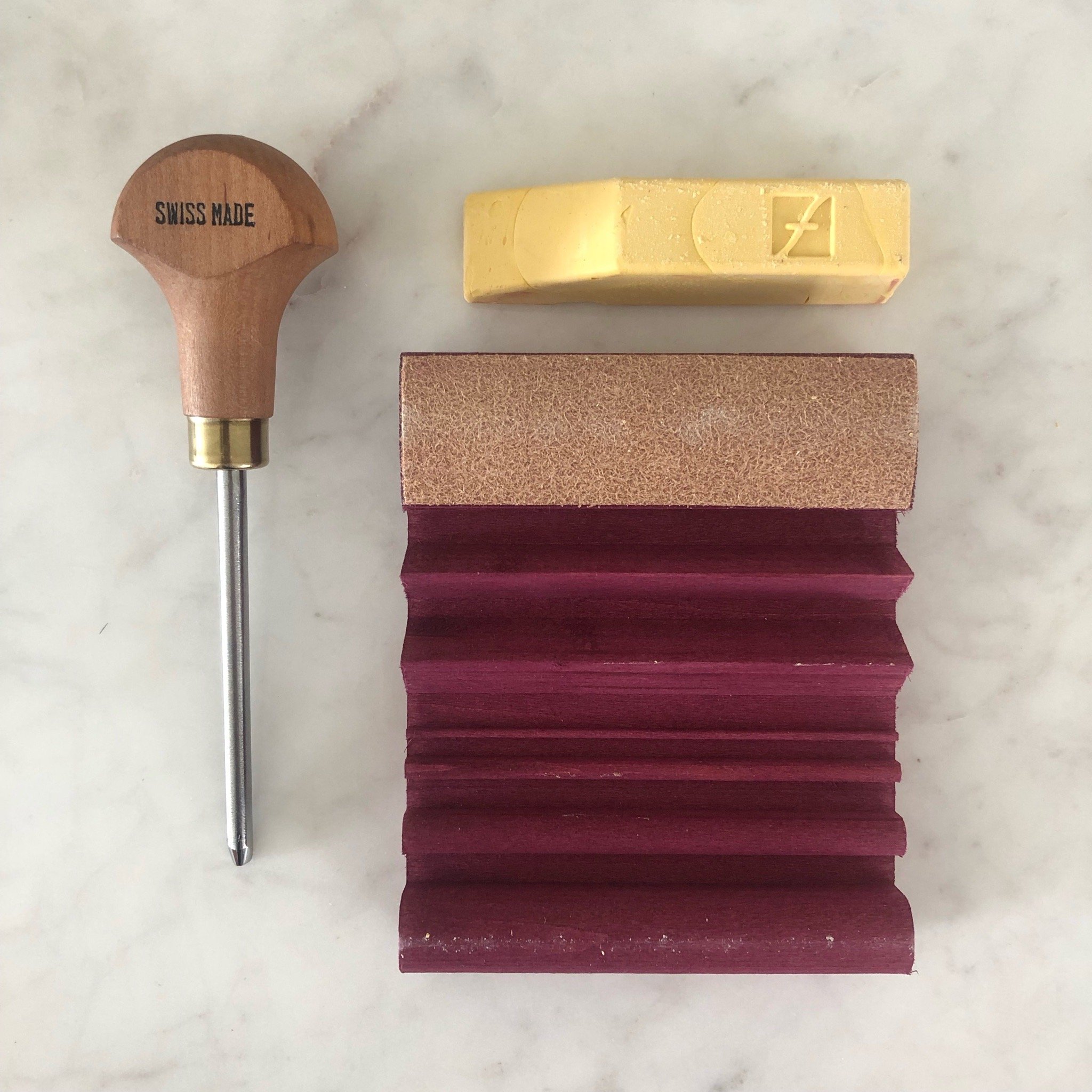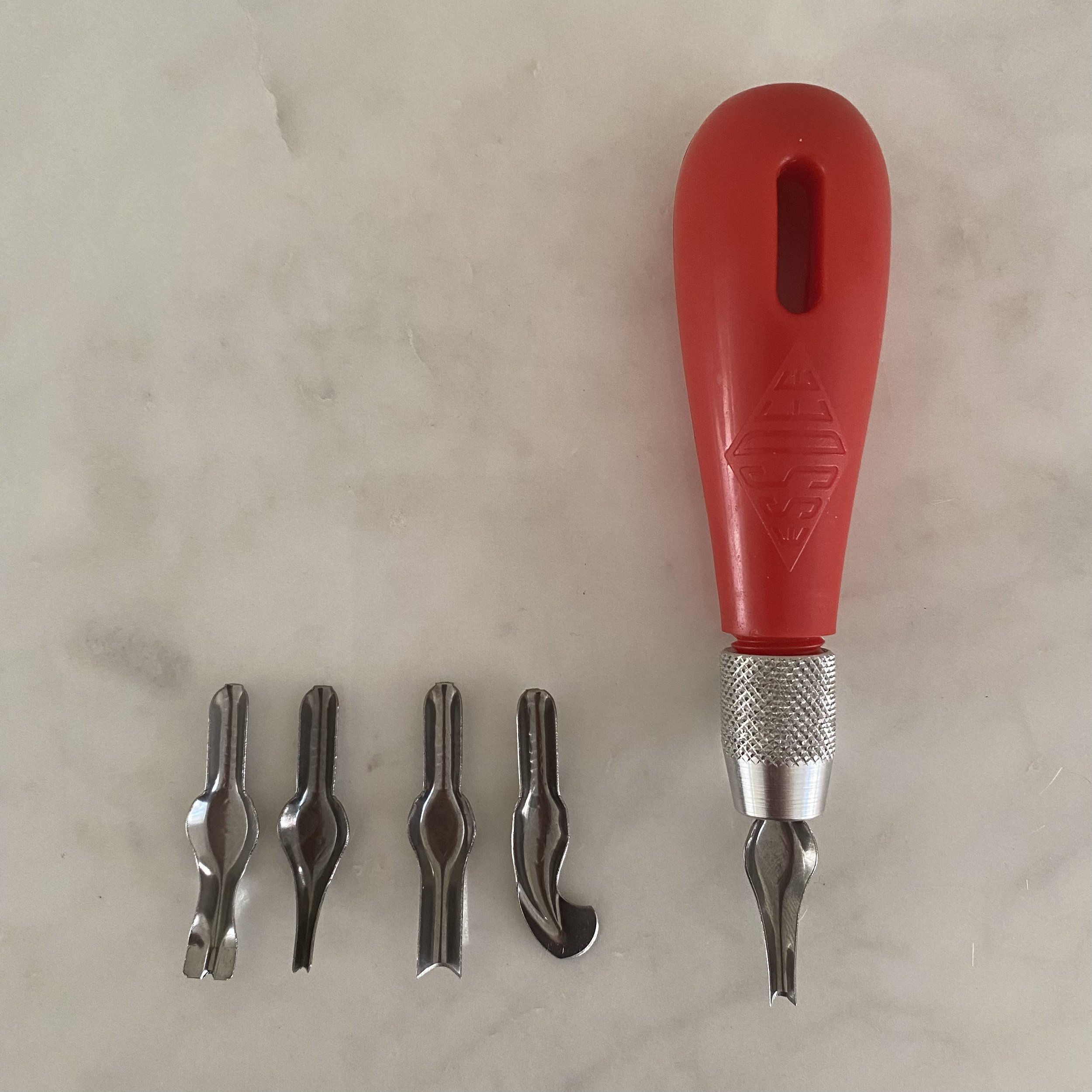Beginners Guide To Lino Print: Choosing Linocut Tools and Materials
Lino printing is a printmaking technique that involves cutting away parts of a block of linoleum with appropriate carving tools to create a design. The carved lino is then inked and transferred onto paper to create a print.
If you are new to lino printing, I have a helpful beginners guide available, where I set out what equipment you need and a step-by-step guide to creating your first lino print.
Lino printing requires a few tools and materials to successfully create the artwork and it can be daunting for beginners to understand the differences between brands. In this blog post I take a closer look at different lino printing tools and materials, as well as my own personal preferences, to help with the decision making process.
Table of Contents
Lino for Lino Printing
Lino printing surfaces - Essdee Softcut, Speedball Speedy-Carve, Traditional Lino and Japenese Vinyl
Lino is the material that is carved into, before it is inked and transferred to paper. In general, people start with a traditional grey, hessian-backed Lino block, but there are actually quite a few different types of lino block, each with their own qualities.
I have written a detailed blog post about the pros and cons of each Lino printing surface, which you can read for more information, whilst the summary below will provide you with a summary for each surface.
Traditional Lino is a hessian backed grey lino. I use this type of lino for many of my projects as it holds detail well and it is better for the environment. It is also one of the easier materials to draw or transfer your design onto. Traditional lino degrades over time, so finished Lino blocks won’t last forever, but it is the cheapest of all the surfaces and widely available from most art retailers.
Essdee Softcut is usually cream in colour and made of soft rubber-like material. This lino is easy to carve as less pressure is required when compared with traditional lino. This makes it a great surface for beginners. It is popular with more experienced printmakers too and does not degrade over time the way traditional Lino does.
Speedy-Carve by Speedball is a thick, soft, pink carving material. Similar to Softcut in terms of ease of carving. Due to the thickness of the rubber, this is the worst for the environment and also the most expensive of the surfaces.
Japanese Vinyl is a double sided material that is blue on one side, green on the other, you can carve into either side. When you cut into it, you will see a black layer, which is useful to show where you have previously cut. It is easy to carve, with less pressure needed than traditional lino, but it is not as soft as SoftCut or Speedy-Carve. This type of lino is less widely available.
My recommendations:
As a beginner, I found Essdee Softcut to be a great material to gain confidence in carving
More often than not, I use traditional Lino as I find it holds my design the best and it is important to me that I use a material that is better for the environment
I use Japanese Vinyl and Speedy-Carve occasionally as I like to experiment
Lino Cutting Tools
It is important that you choose the right cutting tools to ensure that you can achieve clean lines and avoid mistakes carving your design. There are a variety of cutting tools that can be used to carve the linoleum block, including lino cutting knives, gouges, V-tools and U-tools.
Each tool has a different function and can serve different styles and artists needs e.g. smaller cutters for precise detailing and larger cutters to clear large areas. The U-tools are often used to carve softer lines, whereas the V-tools are sharper and provide more accuracy for edges and corners.
As you learn more about the lino cutting tools, you will notice that you can get both fixed and replaceable blades. The higher quality tools tend to come with fixed blades, whilst the more budget versions have replaceable blades. Due to costs, the replaceable blades are better for those just starting out with lino printing, moving on to fixed blade varieties once they have more experience.
Essdee Lino Cutting Tools - The Esdeee lino cutting tools are a great set for a Lino print beginner. These cutting tools come in a handy case that doubles up as a baren to aid with transferring your design to paper. There is a variety of cutting heads providing an opportunity to experiment. The tools work well on Essdee Softcut, but it’s harder to create sharp lines on traditional lino.
NOTE: I have written a full review of the Essdee Lino Cutting and Printing Kit, that you may find useful.
Speedball Linoleum Cutter Assortment - The Speedball Cutter set is very similar to the Essdee cutting tools set (except it doesn’t include a baren). This is a great beginners set as it is fairly inexpensive and comfortable to use. It comes with a variety of different types of blades that fix to the plastic handle, including small and large ‘V’ Gouge, small and large ‘U’ Gouge, a square Gouge and a knife. The blades can also be replaced if they become blunt.
Pfeil Palm Lino Cutting Lino Tool - The Palm lino cutting tools, with their mushroom-shaped wooden handles feel comfortable to hold and provide good control. The Palm lino cutting tool comes in a huge range of sizes and options. They can be bought individually or in sets. They are relatively expensive, but worth the investment for the more advanced Lino printmaker.
Flexcut Carving Tools - Flexcut do a Micro Palm Set which is great for miniature and fine detail work. They are relatively expensive, but can be sharpened and will last a long time.
Power Grip Carving Tools - The Power Grip carving tools are Japanese made. These robust cutters come with a long honed wooden handle and sharp, high quality steel blades. Power Grip Tools are available in 1.5mm V, 1.5mm U and 3mm U. These Power Grip carving tools are very good quality.
My recommendations:
For beginners, the Essdee lino cutting tools are a great set to explore lino printing. For a full review of the Essdee Lino Cutting and Printing Kit, please see my blog post here.
My personal go-to brand is Pfeil. I bought a set that included a variety of different shape cutters that has stood me in good stead.
If you invest in the more expensive carving tools, it is really important to keep them sharp. I would recommend the Flexcut Slipstrop carving tool sharpener
Lino Printing Ink
There are a variety of inks available that are suitable for lino printing. The main choice is between a water-based or oil-based ink. For a beginner I would recommend one of the cheaper water-based inks, such as Speedball or Essdee. They come in a huge range of colours and are great for experimenting.
The cheaper inks tend to dry really quickly, which can be helpful if you want to print different layers of your Lino print as you don’t have to wait long for each layer to dry before you print the next. A disadvantage is that you have to work quickly as you don’t want the ink to dry as you are rolling it.
As confidence is gained, it is worth trying different brands and deciding on your own personal preferences.
My recommendation:
Cranfield Caligo Safe Wash Relief Ink - The finish is really smooth and rich. Although these inks are oil-based, they can be cleaned up with soap and water (check product details for full disposal information). It is worth noting that it takes a few days for this ink to dry.
Ink Rollers for Lino Printing
Ink rollers are used to apply ink to your lino. They come in a range of sizes and can be made from materials such as rubber, foam, or plastic. Once again Essdee and Speedball have some cost-effective ink rollers. The standard size is about 4” and that would be a great place to start. As confidence is gained, it is worth experimenting with smaller or larger rollers, depending on the size of your Lino block.
My recommendations:
My favourite is a small 2” Speedball ink roller. I like to work with a smaller roller as I find I can be more accurate, but this is personal preference.
Paper for Lino Printing
If you are new to Lino printing, the huge choice of paper can be daunting and it can be difficult to know where to start.
Having been through it myself, there is no right or wrong paper and the best way to find your favourite(s) is to experiment with different types and see how you feel. Having said that, I do have some tips on where to start:
Start with paper that is recommended for printmaking. On websites such as Handprinted, Jackson Art or Lawrence Art, there is a printing section where it will list all the suitable paper. Check the description for terms such as ‘Lino printing’, ‘relief printing’ or ‘block printing’.
If you are printing by hand, you are likely to find it easier to get a smooth, even print by using a light or light-medium weight paper, from 80-200gsm.
If you are using a printing press, heavy weight papers from 250gsm work well.
My recommendations:
If I am using light-weight paper, I like to use Lokta paper with a weight of 80gsm. It comes with a beautiful texture and in a huge variety of colours, so it can be great to experiment with.
Strathmore Pro-Art Printmaking Paper at 120gsm, is a relatively inexpensive paper available on Amazon that is lovely to print on by hand
My favourite paper to use on a printing press is Somerset at a weight of 250gsm. It is available in large sheets that you cut or tear down to the required size.
Baren for Lino Printing
A wooden spoon and Japanese Bamboo Baren
In Lino printmaking, a Baren is the tool used to press down on the paper when it is on top of your inked Lino to create the print. A favourite tool of a printmaker is the humble wooden spoon. This is an inexpensive way to apply pressure to the paper.
Another fairly inexpensive tool is the Japenese Bamboo Baren. As you become more experienced, tools such as the Speedball baren or a glass baren can be used and are likely to improve the consistency and ease of printing.
You may feel it is worth investing in a Sláma Press. This baren is top of the range and contains steel ball to achieve the even pressure of a printing press, without taking up the space a printing press requires.
My recommendations:
A wooden or metal spoon - It is great when you can use a tool that is found in any kitchen throughout the world and is very effective in hand-printing. Most printmakers seem to prefer the wooden spoon, but my personal preference is a metal dessert spoon.
A Japanese Bamboo Baren - Only slightly more expensive than the humble spoon, a Japanese Bamboo Baren is a great tool for hand-printing. I tend to use this to smooth my paper over the Lino, before applying pressure with a metal spoon or Sláma Press.
Sláma Press - I found the Sláma Press improved the consistency and speed of my print-making.
Block Printing Press
A3 Pooki Press for printmaking
A printing press is not strictly necessary for lino printing, but it can make the process easier and produce more consistent prints. A press applies even pressure to the Lino and paper, which can help to ensure a clean, crisp print. As experience is gained, a printing press is a very worthwhile investment.
There are some great table-top printing presses available, such as Pooki Press and Woodzilla. These presses usually come in sizes up to A3 and take up relatively little room in your home or studio.
For a traditional printmaking press, it is worth looking into Ironbridge printmakers. These are very large printing presses and great for large-scale work.
My recommendations:
I own an A3 Pooki Press. This works really well for me as it has improved the consistency and speed of my printmaking, but does not take up as much room as a traditional printmaking press.
I hope you have found this blog post useful. If you have any recommendations you think I should include here, please email me at [email protected].








